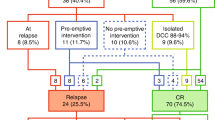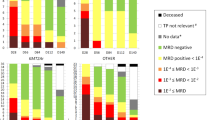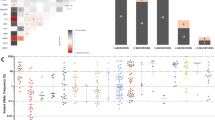Abstract
The t(6;9)(p23;q34) is a recurrent chromosomal abnormality observed in 1% of acute myelogenous leukemia (AML), which generates a fusion transcript between DEK and CAN/NUP214 genes. We used a DEK-CAN real-time quantitative (RQ)-PCR strategy to analyze 79 retrospective and prospective samples from 12 patients. Five patients reached DEK-CAN negativity (sensitivity 10−5); all underwent early allogeneic hematopoietic stem cell transplantation (median 5.5 months from diagnosis) with some demonstrating molecular positivity at the time of allograft. All four cases in CCR with adequate follow-up (median 18.5 months, range 13–95) demonstrate persistent molecular negativity, whereas all seven patients with persistent DEK-CAN positivity died at a median of 12 months from diagnosis (range 7–27). We conclude that DEK-CAN molecular monitoring by RQ-PCR in t(6;9) malignancies is a useful tool for individual patient management and that molecular negativity is indispensable for survival, but should not be a prerequisite for allografting in this rare, poor prognosis, subset of AML.
This is a preview of subscription content, access via your institution
Access options
Subscribe to this journal
Receive 12 print issues and online access
$259.00 per year
only $21.58 per issue
Buy this article
- Purchase on Springer Link
- Instant access to full article PDF
Prices may be subject to local taxes which are calculated during checkout



Similar content being viewed by others
References
Rowley JD, Potter D . Chromosomal banding patterns in acute nonlymphocytic leukemia. Blood 1976; 47: 705–721.
Lillington DM, MacCallum PK, Lister TA, Gibbons B . Translocation t(6;9)(p23;q34) in acute myeloid leukemia without myelodysplasia or basophilia: two cases and a review of the literature. Leukemia 1993; 7: 527–531.
Alsabeh R, Brynes RK, Slovak ML, Arber DA . Acute myeloid leukemia with t(6;9)(p23;q34): association with myelodysplasia, basophilia, and initial CD34 negative immunophenotype. Am J Clin Pathol 1997; 107: 430–437.
Soekarman D, von Lindern M, Daenen S, de Jong B, Fonatsch C, Heinze B et al. The translocation (6;9)(p23;q34) shows consistent rearrangement of two genes and defines a myeloproliferative disorder with specific clinical features. Blood 1992; 79: 2990–2997.
Shapira MY, Hirshberg B, Amir G, Rund D . (6;9) translocation in myelodysplastic syndrome. Cancer Genet Cytogenet 1999; 112: 57–59.
von Lindern M, Poustka A, Lerach H, Grosveld G . The (6;9) chromosome translocation, associated with a specific subtype of acute nonlymphocytic leukemia, leads to aberrant transcription of a target gene on 9q34. Mol Cell Biol 1990; 10: 4016–4026.
Waldmann T, Eckerich C, Baack M, Gruss C . The ubiquitous chromatin protein DEK alters the structure of DNA by introducing positive supercoils. J Biol Chem 2002; 277: 24988–24994.
Waldmann T, Baack M, Richter N, Gruss C . Structure-specific binding of the proto-oncogene protein DEK to DNA. Nucleic Acids Res 2003; 31: 7003–7010.
Casas S, Nagy B, Elonen E, Aventin A, Larramendy ML, Sierra J et al. Aberrant expression of HOXA9, DEK, CBL and CSF1R in acute myeloid leukemia. Leuk Lymphoma 2003; 44: 1935–1941.
Boer J, Bonten-Surtel J, Grosveld G . Overexpression of the nucleoporin CAN/NUP214 induces growth arrest, nucleocytoplasmic transport defects, and apoptosis. Mol Cell Biol 1998; 18: 1236–1247.
Kraemer D, Wozniak RW, Blobel G, Radu A . The human CAN protein, a putative oncogene product associated with myeloid leukemogenesis, is a nuclear pore complex protein that faces the cytoplasm. Proc Natl Acad Sci USA 1994; 91: 1519–1523.
von Lindern M, Breems D, van Baal S, Adriaansen H, Grosveld G . Characterization of the translocation breakpoint sequences of two DEK-CAN fusion genes present in t(6;9) acute myeloid leukemia and a SET-CAN fusion gene found in a case of acute undifferentiated leukemia. Genes Chromosomes Cancer 1992; 5: 227–234.
Graux C, Cools J, Melotte C, Quentmeier H, Ferrando A, Levine R et al. Fusion of NUP214 to ABL1 on amplified episomes in T-cell acute lymphoblastic leukemia. Nat Genet 2004; 36: 1084–1089.
von Lindern M, Fornerod M, van Baal S, Jaegle M, de Wit T, Buijs A et al. The translocation (6;9), associated with a specific subtype of acute myeloid leukemia, results in the fusion of two genes, dek and can, and the expression of a chimeric, leukemia-specific dek-can mRNA. Mol Cell Biol 1992; 12: 1687–1697.
Jaeger U, Kainz B . Monitoring minimal residual disease in AML: the right time for real time. Ann Hematol 2003; 82: 139–147.
Yin JA, Tobal K . Detection of minimal residual disease in acute myeloid leukaemia: methodologies, clinical and biological significance. Br J Haematol 1999; 106: 578–590.
Schnittger S, Weisser M, Schoch C, Hiddemann W, Haferlach T, Kern W . New score predicting for prognosis in PML-RARA+, AML1-ETO+, or CBFBMYH11+ acute myeloid leukemia based on quantification of fusion transcripts. Blood 2003; 102: 2746–2755.
Boer J, Mahmoud H, Raimondi S, Grosveld G, Krance R . Loss of the DEK-CAN fusion transcript in a child with t(6;9) acute myeloid leukemia following chemotherapy and allogeneic bone marrow transplantation. Leukemia 1997; 11: 299–300.
Nakano H, Shimamoto Y, Suga K, Kobayashi M . Detection of minimal residual disease in a patient with acute myeloid leukemia and t(6;9) at the time of peripheral blood stem cell transplantation. Acta Haematol 1995; 94: 139–141.
Maeda T, Kosugi S, Ujiie H, Osumi K, Fukui T, Yoshida H et al. Localized relapse in bone marrow in a posttransplantation patient with t(6;9) acute myeloid leukemia. Int J Hematol 2003; 77: 522–525.
Toyosawa M, Shinohara K, Ariyoshi K, Ando T, Kobayashi M, Hikiji K . The detection of minimal residual disease by DEK/CAN chimeric m-RNA in a case of AML M2 with translocation t(6;9) (p23;q34) after chemotherapy and peripheral blood stem cell transplantation. Rinsho Ketsueki 1997; 38: 33–40.
Ostergaard M, Stentoft J, Hokland P . A real-time quantitative RT-PCR assay for monitoring DEK-CAN fusion transcripts arising from translocation t(6;9) in acute myeloid leukemia. Leuk Res 2004; 28: 1213–1215.
Tobal K, Frost L, Liu Yin JA . Quantification of DEK-CAN fusion transcript by real-time reverse transcription polymerase reaction in patients with t(6;9) acute myeloid leukemia. Haematologica 2004; 89: 1267–1269.
Beillard E, Pallisgaard N, van der Velden VH, Bi W, Dee R, van der Schoot E et al. Evaluation of candidate control genes for diagnosis and residual disease detection in leukemic patients using ‘real-time’ quantitative reverse-transcriptase polymerase chain reaction (RQ-PCR)—a Europe against cancer program. Leukemia 2003; 17: 2474–2486.
Gabert J, Beillard E, van der Velden VH, Bi W, Grimwade D, Pallisgaard N et al. Standardization and quality control studies of ‘real-time’ quantitative reverse transcriptase polymerase chain reaction of fusion gene transcripts for residual disease detection in leukemia—a Europe Against Cancer program. Leukemia 2003; 17: 2318–2357.
Libura M, Asnafi V, Tu A, Delabesse E, Tigaud I, Cymbalista F et al. FLT3 and MLL intragenic abnormalities in AML reflect a common category of genotoxic stress. Blood 2003; 102: 2198–2204.
Thiede C, Steudel C, Mohr B, Schaich M, Schakel U, Platzbecker U et al. Analysis of FLT3-activating mutations in 979 patients with acute myelogenous leukemia: association with FAB subtypes and identification of subgroups with poor prognosis. Blood 2002; 99: 4326–4335.
Pearson MG, Vardiman JW, Le Beau MM, Rowley JD, Schwartz S, Kerman SL et al. Increased numbers of marrow basophils may be associated with a t(6;9) in ANLL. Am J Hematol 1985; 18: 393–403.
Cuneo A, Kerim S, Vandenberghe E, Van Orshoven A, Rodhain J, Bosly A et al. Translocation t(6;9) occurring in acute myelofibrosis, myelodysplastic syndrome, and acute nonlymphocytic leukemia suggests multipotent stem cell involvement. Cancer Genet Cytogenet 1989; 42: 209–219.
Byrd JC, Mrozek K, Dodge RK, Carroll AJ, Edwards CG, Arthur DC et al. Pretreatment cytogenetic abnormalities are predictive of induction success, cumulative incidence of relapse, and overall survival in adult patients with de novo acute myeloid leukemia: results from Cancer and Leukemia Group B (CALGB 8461). Blood 2002; 100: 4325–4336.
Slovak ML, Kopecky KJ, Cassileth PA, Harrington DH, Theil KS, Mohamed A et al. Karyotypic analysis predicts outcome of preremission and postremission therapy in adult acute myeloid leukemia: a Southwest Oncology Group/Eastern Cooperative Oncology Group Study. Blood 2000; 96: 4075–4083.
Gallagher RE, Yeap BY, Bi W, Livak KJ, Beaubier N, Rao S et al. Quantitative real-time RT-PCR analysis of PML-RAR alpha mRNA in acute promyelocytic leukemia: assessment of prognostic significance in adult patients from intergroup protocol 0129. Blood 2003; 101: 2521–2528.
Tobal K, Newton J, Macheta M, Chang J, Morgenstern G, Evans PA et al. Molecular quantitation of minimal residual disease in acute myeloid leukemia with t(8;21) can identify patients in durable remission and predict clinical relapse. Blood 2000; 95: 815–819.
Morschhauser F, Cayuela JM, Martini S, Baruchel A, Rousselot P, Socie G et al. Evaluation of minimal residual disease using reverse-transcription polymerase chain reaction in t(8;21) acute myeloid leukemia: a multicenter study of 51 patients. J Clin Oncol 2000; 18: 788–794.
Ohminami H, Yasukawa M, Kaneko S, Yakushijin Y, Abe Y, Kasahara Y et al. Fas-independent and nonapoptotic cytotoxicity mediated by a human CD4(+) T-cell clone directed against an acute myelogenous leukemia-associated DEK-CAN fusion peptide. Blood 1999; 93: 925–935.
Makita M, Azuma T, Hamaguchi H, Niiya H, Kojima K, Fujita S et al. Leukemia-associated fusion proteins, dek-can and bcr-abl, represent immunogenic HLA-DR-restricted epitopes recognized by fusion peptide-specific CD4+ T lymphocytes. Leukemia 2002; 16: 2400–2407.
Acknowledgements
We greatly acknowledge all the physicians and biologists for providing clinical and biological data and samples for DEK-CAN monitoring. We especially thank Dr Vasselon (Hôpital Nord, St-Etienne, France), Pr Leblond and Pr Merle-Béral (Hôpital de la Pitié-Salpétrière, Paris, France), Pr Leverger and Dr Adam (Hôpital Trousseau, Paris, France), Pr Rio (Hôtel Dieu, Paris, France), Dr Noguerra and Pr Baruchel (Hôpital St-Louis, Paris, France). Marta Libura is a recipient of a scholarship from the Postgraduate School of Molecular Medicine at the Medical University of Warsaw. This work was supported by la Ligue Nationale Contre le Cancer and l'Association de la Recherche sur le Cancer (ARC).
Author information
Authors and Affiliations
Corresponding author
Rights and permissions
About this article
Cite this article
Garçon, L., Libura, M., Delabesse, E. et al. DEK-CAN molecular monitoring of myeloid malignancies could aid therapeutic stratification. Leukemia 19, 1338–1344 (2005). https://doi.org/10.1038/sj.leu.2403835
Received:
Accepted:
Published:
Issue Date:
DOI: https://doi.org/10.1038/sj.leu.2403835
Keywords
This article is cited by
-
Allogeneic hematopoietic stem cell transplantation for acute myeloid leukemia with t(6;9)(p23;q34) dramatically improves the patient prognosis: a matched-pair analysis
Leukemia (2012)
-
The nuclear envelope environment and its cancer connections
Nature Reviews Cancer (2012)
-
Prognostic factors for acute myeloid leukemia patients with t(6;9)(p23;q34) who underwent an allogeneic hematopoietic stem cell transplant
Leukemia (2012)
-
The t(6;9) associated DEK/CAN fusion protein targets a population of long-term repopulating hematopoietic stem cells for leukemogenic transformation
Leukemia (2010)
-
Interactive diagnostics in the indication to allogeneic SCT in AML
Bone Marrow Transplantation (2009)



